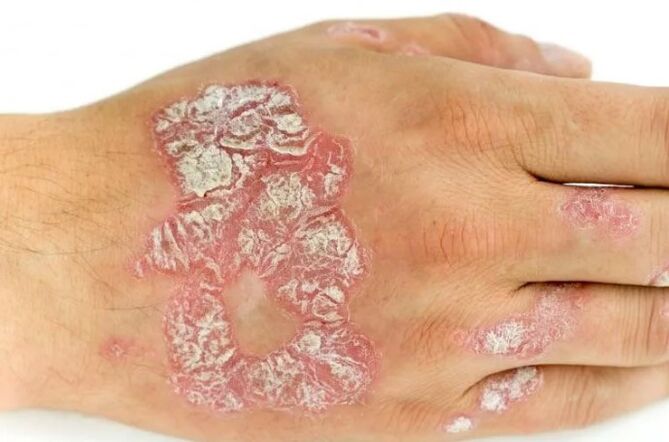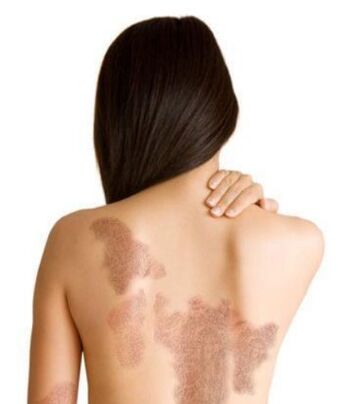Despite the unknown etiology of psoriasis and the factors that cause it, the phases of its development are well studied.The classification of psoriasis in the stadium facilitates the evaluation of the course of the disease, helps identify sensitivity to a certain method of treatment and determine patients's tactics.

The phases of psoriasis are classified according to the nature of exacerbation (or the activity of the inflammation process) and gravity.
Psoriasis phase depending on exacerbation
Psoriasis is a disease that has 3 phases:
- progressive;
- stationary;
- Retrogressive;
- remission.
Symptoms of the progressive phase
This phase is characterized by evident signs of exacerbation.Presented multiple skin eruptions appear on the skin, with the shape of red nodules (papules, tubercles) with an oval or rounded shape.They merge and form outbreaks that occupy a vast area, their surface has actively peeled, the patient at the same time experiences a serious itching of the skin and sometimes a burning feeling.The itch can be exhausting and disturb the patient, not only during ordinary life, but also in a dream, itching to intensify when contacting clothes.After the delay of the stairs, the surface can bathe and turn into a nourishing medium for the propagation of bacteria.
The main manifestations of the progressive phase are:
- the appearance of papules on the extensor surfaces of the limbs and on the body;
- the merger of the papules in conglomerates ("plates"), with a whitish color;
- peeling of the surface of the conglomerates;
- There are no stairs in the region of the edges of the plates, but there is a hyperemic edge;
- The edges of the plates are compact;
- The presence of a Kebner phenomenon: when the mechanical damage (cut, scratch) appears on uninhabited skin, a new psoriatic plaque is formed in its place.
The more intense during the progressive phase it is the redness of the skin, the more active the inflammation process is.The most dangerous consequence of psoriasis is psoriatic arthritis, while strong joint pain occurs, consequently, the joints are deformed.

Stadium stadium symptoms
With the beginning of the stationary phase, a gradual attenuation of the exacerbation process occurs.At the same time, the papules become pale, they do not appear from red in pink, new rashes in this period.The surface of the knots has the shape of "plates", it is dense, covered by a crust, which is represented by numerous scales of dry skin.The nature of the healing of the papules starts from the center on the outskirts.The presence of a stationary phase of psoriasis confirms the effectiveness of the treatment.
The main events of this phase are:
- Lack of rashes of new papules;
- Existing plates stop their growth;
- The surface of the plates is covered by stairs;
- The red edge disappears around the shaky plates;
- Kebner's phenomenon disappears.
Symptoms of the regression stadium
In the regression phase, the process is involution.The "plates" are resolved, forming skin depigmentation areas.The itching of the skin gradually disappears, the signs of peeling decrease.
Signs of regression of psoriasis:
- There is an edge of Voronov around the plates (dense fold-visible ring located around psorial plates);
- reduction and gradual disappearance of peeling;
- On the plaques website, depigmentation areas (white or dark) are formed.
In the regression phase, the plates disappear completely, the remains of the plates are possible in the area: knees, elbows, abdomen, buttocks.
Remission
Remission is the stage of apparent recovery.During remission, psoriasis is in a "sleeping" state, but does not disappear from the body.The remission of psoriasis lasts until the next exacerbation (progressive phase).

It should be noted that during the exacerbation of psoriasis, the general condition of a person does not change, goes to work, is engaged in family family issues.Psoriasis brings only an aesthetic and cosmetic defect to a person: the patient's skin graffinies a lot, a person cannot wear open clothes, if you observe an exacerbation in summer, a person cannot visit the swimming pool, go to massage, cosmetic procedures, etc.
Psoriasis phase depending on the injury area
The severity of psoriasis also depends on the area of skin lesions.So, in a slight phase, only 3%of the surface of the skin is influenced, with an average - from 3 to 10%and with a heavy - more than 10%.Psoriasis, which caused damage to the joints, belongs to a serious degree, in which case the area of skin lesions is not taken into consideration.You can measure the area of damage yourself.For this purpose, the open palm rule is used (the skin area corresponding to the human palm area is 1% of the entire body surface).
Pasi index
The general system for the evaluation of the gravity of psoriasis is assessed using the Pasi index, which includes an evaluation of the prevalence and gravity, as well as the severity of the manifestation of the disease.This indicator is estimated from 0 to 72
In addition to the different phases, psoriasis can have different types: seborrheic, exudative, footbed, interstigious, old, rudioid, fierce, nail psoriasis and mucous membranes.It is impossible to completely take care of psoriasis, but a long remission can be obtained.This is this objective that is pursued with modern treatment methods.
























